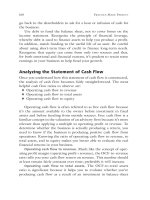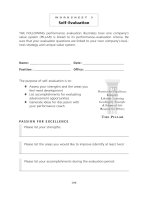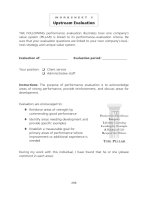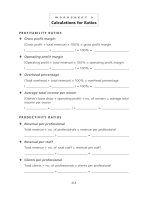practice makes perfect basic spanish
Bạn đang xem bản rút gọn của tài liệu. Xem và tải ngay bản đầy đủ của tài liệu tại đây (1.26 MB, 273 trang )
PRACTICE
MAKES
PERFECT
Dorothy Richmond
Basic
Spanish
New York Chicago San Francisco Lisbon London Madrid Mexico City
Milan New Delhi San Juan Seoul Singapore Sydney Toronto
Copyright © 2009 by The McGraw-Hill Companies, Inc. All rights reserved. Except as permitted under the United States Copyright Act of 1976, no part of
this publication may be reproduced or distributed in any form or by any means, or stored in a database or retrieval system, without the prior written permis-
sion of the publisher.
ISBN: 978-0-07-164223-1
MHID: 0-07-164223-4
The material in this eBook also appears in the print version of this title: ISBN: 978-0-07-145805-4, MHID: 0-07-145805-0.
All trademarks are trademarks of their respective owners. Rather than put a trademark symbol after every occurrence of a trademarked name, we use names
in an editorial fashion only, and to the benefit of the trademark owner, with no intention of infringement of the trademark. Where such designations appear in
this book, they have been printed with initial caps.
McGraw-Hill eBooks are available at special quantity discounts to use as premiums and sales promotions, or for use in corporate training programs.
To contact a representative please visit the Contact Us page at www.mhprofessional.com.
TERMS OF USE
This is a copyrighted work and The McGraw-Hill Companies, Inc. (“McGraw-Hill”) and its licensors reserve all rights in and to the work. Use of this work
is subject to these terms. Except as permitted under the Copyright Act of 1976 and the right to store and retrieve one copy of the work, you may not decom-
pile, disassemble, reverse engineer, reproduce, modify, create derivative works based upon, transmit, distribute, disseminate, sell, publish or sublicense the
work or any part of it without McGraw-Hill’s prior consent. You may use the work for your own noncommercial and personal use; any other use of the work
is strictly prohibited. Your right to use the work may be terminated if you fail to comply with these terms.
THE WORK IS PROVIDED “AS IS.” McGRAW-HILL AND ITS LICENSORS MAKE NO GUARANTEES OR WARRANTIES AS TO THE ACCURACY,
ADEQUACY OR COMPLETENESS OF OR RESULTS TO BE OBTAINED FROM USING THE WORK, INCLUDING ANY INFORMATION THAT CAN
BE ACCESSED THROUGH THE WORK VIA HYPERLINK OR OTHERWISE, AND EXPRESSLY DISCLAIM ANY WARRANTY, EXPRESS OR
IMPLIED, INCLUDING BUT NOT LIMITED TO IMPLIED WARRANTIES OF MERCHANTABILITY OR FITNESS FOR A PARTICULAR PURPOSE.
McGraw-Hill and its licensors do not warrant or guarantee that the functions contained in the work will meet your requirements or that its operation will be
uninterrupted or error free. Neither McGraw-Hill nor its licensors shall be liable to you or anyone else for any inaccuracy, error or omission, regardless of
cause, in the work or for any damages resulting therefrom. McGraw-Hill has no responsibility for the content of any information accessed through the work.
Under no circumstances shall McGraw-Hill and/or its licensors be liable for any indirect, incidental, special, punitive, consequential or similar damages that
result from the use of or inability to use the work, even if any of them has been advised of the possibility of such damages. This limitation of liability shall
apply to any claim or cause whatsoever whether such claim or cause arises in contract, tort or otherwise.
iii
Contents
Preface v
I 1 De nite articles · Family 3
2 Inde nite articles · Around the house 6
3 Yo tengo and yo quiero · Animals 9
4 The use of hay · The classroom 12
5 Subject pronouns · Common -ar verbs ·
Regular -ar verbs · Days of the week 15
1 Lecciones 1–5 20
II 6 Clothing · -Ar verb endings 27
7 Regular -er verbs · Food and drink 31
8 -Er verb endings · Common -er verbs 34
9 Forms of adjectives · Colors · Expressing “I like” 37
10 Descriptive adjectives · Expressing “more than” 40
2 Lecciones 6–10 44
III 11 Regular -ir verbs · Common -ir verbs 51
12 Asking questions · Interrogatives 54
13 Ser · Professions 57
14 Possessive adjectives · Using ser 60
15 Tener · Things in the house 63
3 Lecciones 11–15 66
IV 16 Estar · Locations 73
17 Moods · Expressing emotions 76
18 Using estar · Physical condition 79
19 Querer · More clothing 82
20 Numbers · Expressing age · Idioms with tener ·
Using tener que 88
4 Lecciones 16–20 92
iv Contents
V 21 Hacer · Weather 99
22 Telling time 102
23 Jugar · Sports and games 107
24 Ir · Contractions · Transportation 110
25 Five sensing verbs · Things to read 113
5 Lecciones 21–25 116
VI 26 Poder · Adverbs 125
27 Two-verb constructions · Adverbs of time 128
28 Two-verb questions · More food 131
29 Comparative adjectives · Comparisons 134
30 Preposition ѿ verb · Things in the house 138
6 Lecciones 26–30 141
VII 31 Demonstrative adjectives · Common stem-changing -ar verbs 149
32 -Ar verbs with o ue stem change · Unwritten “it” 152
33 -Er and -ir verbs with o ue stem change 155
34 Verbs with e ie stem change · Miscellaneous words 159
35 Double negatives 163
7 Lecciones 31–35 167
VIII 36 Direct object pronouns · More professions 175
37 Saber 178
38 Conocer · Personal a · Schools of thought 181
39 Saber and conocer 184
40 Possession with de 187
8 Lecciones 36–40 191
IX 41 Re exive pronouns · Re exive verbs 199
42 Re exive -ar verbs · Articles in the bathroom 202
43 E i stem-changing verbs · Measurements 205
44 Irregular yo forms · Ponerse and quitarse · More clothing 208
45 Indirect object pronouns · Dar 211
9 Lecciones 41–45 214
X 46 Para · Pronouns after prepositions 223
47 Por 226
48 Para and por · Emotions · Idioms with por 229
49 Gustar · Verbs like gustar · Parts of the body 232
50 Ir ѿ a ѿ in nitive · Expressions of future time 237
10 Lecciones 46–50 240
Cumulative paragraphs 245
Answer key 248
English-Spanish glossary 261
Index 266
v
Preface
Practice Makes Perfect: Basic Spanish is an e ective companion text to whatever
book(s) you may be using in your rst- or second-year Spanish class. is highly
useful workbook is well suited for middle school and high school students.
is book is not meant to introduce concepts or to be the primary teaching
tool. Rather, its purpose is to reinforce what has been presented already, whether
by a teacher’s instruction or in a formal textbook. Very basic grammar is pre-
sented, typically in charts, as preparation for the material covered in the exercises.
Exercises use the present tense exclusively. is choice of present tense is contex-
tually appropriate, even when historical gures are mentioned.
e easiest way to know what to expect from Practice Makes Perfect: Basic
Spanish is to scan the Contents. ere you will nd the grammatical concepts and
vocabulary topics covered.
Grammatical concepts are emphasized more than vocabulary, as every stu-
dent needs to master these one at a time and to relative completion. Vocabulary,
on the other hand, is an ongoing process, frequently dictated by the student’s par-
ticular interests and needs.
Also presented, in the early chapters, is crucial everyday vocabulary that
helps the beginning student express himself or herself more clearly and authenti-
cally, even early in the process of learning to speak, write, and read Spanish.
Below is a quick list of what this book provides:
Reinforcement for concepts already presented in another format or setting
An emphasis on broad, basic concepts—not grammatical minutiae
An emphasis on the informal you (tú and vosotros)—in exercises, you is as-
sumed to be the singular familiar form tú and you all is assumed to be the plural
familiar form vosotros
Useful vocabulary lists for a variety of topics
More than entertaining exercises dealing with the basic structure of the
Spanish language
A broad range of fun exercises (true/false, ll in the blank, translations, “Who
am I?”, etc.)
Exercise content infused with famous and popular people and characters, both
current and historical
Ten sets of exercises—called Cumulativos—each of which tests the information
gleaned from the previous ve lessons in a comprehensive way
A nal set of translation exercises that tests the cumulative knowledge acquired
through each of the ten parts of this book
Answers to all exercises
A glossary that draws together vocabulary from throughout the book
vi Preface
Spanish is a beautiful language that you can appreciate and enjoy more fully by mastering
the fundamentals of its structure. is workbook will help you achieve your goals in a user-
friendly, student-driven fashion.
¡Buena suerte!
Acknowledgments
Writing this book was a joy, in large part because some of my favorite people helped or allowed
me the freedom to bring it to fruition.
My husband, Martin, and our daughters, Daisy and Lily, make life and work wonderful sim-
ply because they exist. I am endlessly grateful that our lives are intertwined.
I’ve long known that good students make excellent editors, and this book proves to be no
exception. Margaret Chutich demonstrated nesse in proofreading, making contextual sugges-
tions, and plucking out typos. Margaret also proved that good students make excellent friends.
At McGraw-Hill, I had the good fortune once again to work directly with Christopher Brown,
Language Publisher. Christopher’s kind and gentle nature, combined with an acute attention to
academic detail and his ability to “see” a book long before it’s even begun, make him the perfect
guide in the lengthy and o en adventurous process of writing a book.
Finally, Terry Yokota and Dan Franklin turned my nal manuscript into the book you hold
in your hands. In the world of typography and layout, Terry and Dan are true artists. ey are also
fun to work with, and they amaze me with their accuracy and strong attention to detail.
I am delighted that these people are in my life, and I thank each of them as well as my friends
and extended family members who add much to this world.
1
1 De nite articles · Family 3
2 Inde nite articles · Around the house 6
3 Yo tengo and yo quiero · Animals 9
4 The use of hay · The classroom 12
5 Subject pronouns · Common -ar verbs ·
Regular -ar verbs · Days of the week
15
1 Lecciones 1–5 20
Grammar
De nite articles
Inde nite articles
Yo tengo, yo quiero
Hay
Subject pronouns
Conjugation of regular -ar verbs
Vocabulary
Family members
Around the house
Animals
The classroom
Common -ar verbs
Days of the week
Fun facts
Celebrities
The White House
Winnie the Pooh
Mr. Rogers
Television
Fast food
Characters from Arthur
·
I
·
This page intentionally left blank
3
De nite articles
SINGULAR PLURAL
MASCULINE
el los
FEMININE la las
e de nite article is used much more frequently in Spanish than in
English, for example, Jorge lava los platos George washes dishes.
VOCABULARIO
Los miembros de la familia (Family members)
father el padre
mother la madre
parents los padres
dad el papá
mom la mamá
boy el chico
girl la chica
brother el hermano
sister la hermana
son el hijo
daughter la hija
children los hijos
grandfather el abuelo
grandmother la abuela
grandson el nieto
granddaughter la nieta
uncle el tío
aunt la tía
nephew el sobrino
niece la sobrina
cousin (m.) el primo
cousin ( f.) la prima
family la familia
De nite articles
Family
·
1
·
4 Basic Spanish
1
·
1
EJERCICIO
Traducción simple (Simple translation)
1. the father 10. the aunts
2. the mother 11. the grandmother
3. the fathers 12. the granddaughter
4. the mothers 13. the cousins [f.]
5. the boy 14. the parents
6. the girl 15. the grandson
7. the brother 16. the granddaughters
8. the sister 17. the sons
9. the uncle 18. the family
1
·
2
EJERCICIO
La familia (The family) Match the famous persons named on the left with
the correct family relationship on the right. Some of those named are actual persons;
others are ctional characters.
VOCABULARIO de of
y and
1.
Paris y Nicky Hilton A. la madre y el hijo
2.
Lily y James Potter B. los hermanos
3.
Goldie Hawn y Kate Hudson C. las nietas de George y Barbara Bush
4.
Marge Simpson y Bart Simpson D. la hija de Tom Cruise y Katie Holmes
5.
Babar y Celeste E. el primo y la prima
6.
Suri F. los hijos de la Señora y el Señor Beaudelaire
7.
Luke y Owen Wilson G. los padres de Harry Potter
8.
Jenna y Barbara Bush H. las hermanas
9.
Darth Vader I. la madre y la hija
10.
Violet, Klaus y Sunny J. el padre de Luke Skywalker
De nite articles · Family 5
VOCABULARIO
Everyday words
my mi
your tu
is es
of de
from de
1
·
3
EJERCICIO
Traducción (Translation)
1. My uncle is the brother of my mother.
2. Your mother is my cousin.
3. My grandfather is your uncle.
4. Your grandmother is from China.
5. My family is from Boston.
6. Your sister is my aunt.
7. My dad is the cousin of your uncle.
8. Your mom is the aunt of my daughter.
Hechos divertidos (Fun facts)
Las celebridades (Celebrities)
◆
Julia Roberts es la tía de Emma Roberts.
◆
Danny Masterson (Hyde en El Show de los ’s) es el hermano de Chris Masterson (Fran-
cis en Malcolm en el Medio).
◆
Nicolas Cage (el actor) es el sobrino de Francis Ford Coppola (el director).
◆
Colin Hanks es el hijo de Tom Hanks.
◆
Rumer Willis es la hija de Demi Moore y Bruce Willis.
2
6
·
2
·
Inde nite articles
Around the house
Inde nite articles
SINGULAR PLURAL
MASCULINE
un unos
FEMININE una unas
VOCABULARIO
Por la casa (Around the house)
attic el desván
basement el sótano
bathroom el baño
bedroom el dormitorio
closet el clóset
dining room el comedor
door la puerta
entryway la entrada
garage el garaje
hall el pasillo
house la casa
kitchen la cocina
living room la sala
o ce el despacho
porch el porche
room el cuarto
shower la ducha
window la ventana
yard el jardín
2
·
1
EJERCICIO
Traducción simple (Simple translation)
1. a bedroom
2. a house
3. some bedrooms
4. some houses
5. a basement
6. some bathrooms
7. a kitchen
8. an attic
Inde nite articles · Around the house 7
9. an entryway
10. a closet
11. a hall
12. a yard
13. a dining room
14. a living room
15. some o ces
16. an o ce
17. some kitchens
18. some living rooms
19. a porch
20. some yards
2
·
2
EJERCICIO
La casa (The house) Match each room named on the left with the item you would
likely nd in it. Figure out what each item is by its similarity to its English counterpart.
1. la sala A. la computadora
2.
la cocina B. el carro, el coche
3.
el despacho C. la mini-televisión
4.
el jardín D. el sofá
5.
el garaje E. el refrigerador
6.
el comedor F. el champú y el acondicionador
7.
el dormitorio G. las plantas y las ores
8.
el baño H. el candelabro
VOCABULARIO
Everyday words
one uno, una ( f.)
two dos
three tres
four cuatro
ve cinco
has tiene
doesn’t have no tiene
are son
8 Basic Spanish
2
·
3
EJERCICIO
Traducción (Translation)
1. My kitchen has two windows.
2. Your bedroom doesn’t have a closet.
3. My house has four bedrooms.
4. Your living room has some windows.
5. My bathroom has a door.
6. Your house doesn’t have a door.
7. My basement has ve rooms.
8. Some doors are from France (Francia).
9. Madonna has two sons and a daughter.
10. Lois has ve sons.
Hechos divertidos (Fun facts)
La Casa Blanca (The White House)
La Casa Blanca en Washington, D.C. (la casa o cial del Presidente de los Estados Unidos)
tiene dormitorios, baños, cinco cocinas, cuatro comedores, puertas, ventanas,
tres elevadores, chimeneas, muchas salas y despachos—en total: ¡ cuartos!
3
9
·
3
·
Yo tengo and yo quiero
Animals
Yo tengo, yo quiero
Yo tengo I have
Yo no tengo I don’t have
Yo quiero I want
Yo no quiero I don’t want
VOCABULARIO
Los animales (Animals)
bear el oso
bird el pájaro
bull el toro
cat el gato
chicken el pollo
cow la vaca
dog el perro
donkey el burro
duck el pato
elephant el elefante
sh el pez
horse el caballo
kangaroo el canguro
lamb el cordero
lion el león
monkey el mono
mouse el ratón
pig el cerdo
rabbit el conejo
rat la rata
rooster el gallo
sheep la oveja
tiger el tigre
turkey el pavo
wolf el lobo
3
·
1
EJERCICIO
Traducción (Translation)
1. I have a bear.
2. I don’t have an elephant.
3. I have two ducks.
4. I don’t have three cats.
5. I want a dog.
6. I don’t want a mouse.
10 Basic Spanish
7. I want some cats.
8. I don’t want a rat.
9. I have some monkeys.
10. I want some turkeys.
11. I have the lamb.
12. I don’t have the lion.
13. I want the tiger.
14. I don’t want the pig.
15. I want a rabbit.
3
·
2
EJERCICIO
3·2
¿Dónde está el animal? (Where is the animal?) Place an X in the column
that indicates where you would most likely nd each of the animals listed below:
en la casa (in the house), en la granja (on the farm), or en el zoológico (in the zoo).
en la casa en la granja en el zoológico
1. el pato
2. el tigre
3. el cordero
4. el gato
5. el león
6. el conejo
7. el elefante
8. el caballo
9. el pájaro
10. el mono
11. el toro
12. el cerdo
13. el pavo
Yo tengo and yo quiero · Animals 11
VOCABULARIO
Everyday words
book el libro
for para
in, at, on en
with con
3
·
3
EJERCICIO
3·2
Traducción (Translation)
1. I don’t want a bull in my kitchen.
2. I have two ducks in my living room.
3. I don’t have a car in my garage.
4. I have a monkey for George.
5. I don’t want a bird from China.
6. Hermione has a cat at Hogwarts.
7. My cousin doesn’t have a tiger in the car.
8. I want some rats for my mouse.
9. Scooby-Doo is a dog and Velma is a girl.
10. Shrek has a donkey.
Hechos divertidos (Fun facts)
Winnie the Pooh
◆
A.A. Milne, el padre de Christopher Robin, es el autor de Winnie the Pooh, un libro muy
popular con los chicos y las chicas.
◆
Pooh es un oso.
◆
Eeyore es un burro.
◆
Rabbit es un conejo.
◆
Roo es un canguro (su madre es Kanga).
◆
Tigger es un tigre.
◆
Piglet es un cerdo.
◆
He alump es un elefante.
4
12
·
4
·
The use of hay
The classroom
Hay
Hay . ere is . ere are .
No hay
. ere isn’t . ere aren’t .
¿Hay
? Is there ? Are there ?
¿No hay
? Isn’t there ? Aren’t there ?
Hay is pronounced “eye.”
VOCABULARIO
La sala de clase (The classroom)
assignment la tarea
backpack la mochila
book el libro
chair la silla
chalk la tiza
chalkboard la pizarra
classroom la sala de clase
clock el reloj
desk el escritorio
dictionary el diccionario
eraser el borrador
lesson la lección
lights las luces
map el mapa
notebook el cuaderno
paper el papel
pen la pluma
pencil el lápiz
ruler la regla
school la escuela
student el estudiante, la estudiante
teacher el maestro, la maestra
wall la pared
4
·
1
EJERCICIO
4·1
Traducción compleja (Complex translation)
1. There is a book on the desk.
2. There are two rulers in my desk.
3. There is a map on the wall.
The use of hay · The classroom 13
4. There is a teacher in the classroom.
5. There isn’t a pen on my desk.
6. There isn’t a notebook for the teacher.
7. There aren’t lights in the classroom.
8. Is there chalk for the chalkboard?
9. Is there a clock for the wall?
10. Is there an assignment for the students?
11. There are three maps for the teachers.
12. There is a backpack on the desk.
4
·
2
EJERCICIO
4·1
¿En la pared o en el escritorio? (On the wall or on the desk?)
Are the following items hanging on the wall (en la pared) or sitting on (or in) the desk
(en el escritorio)? Place an X in the appropriate column. If neither is true, place an X
in the no column.
en la pared en el escritorio no
1. el cuaderno
2. el mapa
3. la regla
4. la tarea
5. la maestra
6. la pizarra
7. la pluma
8. el lápiz
9. la silla
10. el reloj
11. el diccionario
12. la estudiante
13. el papel
14. el escritorio
14 Basic Spanish
VOCABULARIO
Everyday words
six seis
seven siete
eight ocho
nine nueve
ten diez
and y
each; every cada
4
·
3
EJERCICIO
4·1
Traducción (Translation)
1. My classroom has a clock on each wall.
2. I have six pens and seven rulers in my backpack.
3. I want eight notebooks for my desk.
4. I don’t have the ruler for my assignment.
5. My teacher has paper and a pen for every student.
6. I want chalk and an eraser for every chalkboard.
7. There is a duck on each desk.
8. Is there a sh in the classroom?
Hechos divertidos (Fun facts)
Mr. Rogers
En la escuela del programa Señor Rogers (en la televisión americana), hay tres estudian tes:
Anna Platypus, el Príncipe Tuesday y Daniel el Tigre. La maestra es una vaca: Harriet Eliza-
beth Cow. La asistenta a la maestra es Dama Elaine. Dama Elaine es la sobrina del Rey (King)
Friday y la Reina (Queen) Sara. Dama Elaine es la prima del Príncipe Tuesday.
15
Subject pronouns
yo I nosotros we (m.)
nosotras we (f.)
tú you (sing., fam.) vosotros you (pl., fam., m.)
vosotras you (pl., fam., f.)
él he ellos they (m.)
ella she ellas they (f.)
usted you (sing., form.) ustedes you (pl., form.)
VOCABULARIO
Unos verbos -ar comunes (Common -ar verbs)
bailar to dance
caminar to walk
cantar to sing
comprar to buy
escuchar to listen (to)
estudiar to study
hablar to speak
mirar to watch, to look (at)
pagar to pay
tocar to play (a musical instrument), to touch
tomar to take, to drink/sip
trabajar to work
Conjugation of regular -ar verbs
hablar to speak, talk
yo hablo nosotros/nosotras hablamos
tú hablas vosotros/vosotras habláis
él habla ellos hablan
ella habla ellas hablan
usted habla ustedes hablan
Subject pronouns
Common -ar verbs
Regular -ar verbs
Days of the week
·
5
·
16 Basic Spanish
5
·
1
EJERCICIO
4·1
Conjugación (Conjugation) Conjugate the following verbs.
él/ella/ nosotros/ vosotros/ ellos/ellas/
yo tú usted nosotras vosotras ustedes
1. hablar
to speak
2. cantar
to sing
3. comprar
to buy
4. estudiar
to study
5. mirar
to watch
6. pagar
to pay
7. tocar
to touch
8. caminar
to walk
9. trabajar
to work
10. tomar
to take
5
·
2
EJERCICIO
4·1
¿Verdadero o falso? (True or false?) Mark the following statements true (V)
or false (F).
1. Yo hablo inglés (English).
2.
Yo estudio español.
3.
Yo no canto en la clase de música.
4.
Yo miro la televisión en mi casa.
5.
Yo bailo con mi maestro/maestra en la sala de clase.
6.
Yo trabajo en la o cina del presidente de los Estados Unidos.
7.
Chris Martin, de la banda Coldplay, toca el piano.
Subject pronouns · Common -ar verbs · Regular -ar verbs · Days of the week 17
8. Muchos actores trabajan en Hollywood.
9.
Nosotros estudiamos mucho en la escuela.
10.
Madonna no canta.
5
·
3
EJERCICIO
4·1
Traducción simple (Simple translation)
1. I speak. 9. She dances.
2. You speak. 10. You watch.
3. He speaks. 11. We take.
4. We speak. 12. We work.
5. They [m.] speak. 13. I sing.
6. I study. 14. You sing.
7. You study. 15. Beyoncé sings.
8. We study.
5
·
4
EJERCICIO
4·4
¿Verdadero o falso? (True or false?) Mark the following statements true (V)
or false (F). Many of the words are new, but with a bit of study you’ll be able to gure
them out.
1. Yo toco el trombón, la trompeta, el clarinete, el violín, el oboe y el saxofón.
2.
Yo no miro la televisión en mi casa.
3.
Yo estudio español.
4.
El presidente de México habla español.
5.
Tom Cruise canta y baila en MTV.
6.
Nosotros estudiamos mucho en la sala de clase.
7.
Mi maestro/maestra trabaja mucho.
8.
Muchas personas hablan con amigos por teléfono celular.
9.
Yo compro los discos compactos en la cafetería.
10.
Nosotros miramos los videos de música en MTV.
11.
Norah Jones y Dave Matthews tocan la tuba.
12.
Hay un teléfono en mi casa.
18 Basic Spanish
VOCABULARIO
Everyday words
a lot mucho
because porque
day el día
money el dinero
5
·
5
EJERCICIO
5·5
Traducción (Translation)
1. I practice the piano every day.
2. We study a lot in the classroom.
3. I buy an iPod because I walk a lot.
4. We walk to my house.
5. I pay because I have the money.
6. You take the money from the girl.
7. I work a lot because I buy a lot.
Hechos divertidos (Fun facts)
La televisión (Television)
En la casa típica en los Estados Unidos, los americanos miran la televisión por ocho horas
cada día. En la casa típica en Francia, los franceses miran la televisión por tres horas cada
día. En la casa típica en Italia, los italianos miran la televisión por cuatro horas cada día. En
Japón, los japoneses miran la televisión por tres horas y media (½) cada día. Es obvio—¡Los
americanos aman la televisión!
VOCABULARIO
Los días de la semana (Days of the week)
Monday el lunes
Tues day el martes
Wednesday el miércoles
ursday el jueves
Friday el viernes
Saturday el sábado
Sunday el domingo
Monday is the rst day of the week on the Spanish calendar. e names of the days
are not capitalized.









